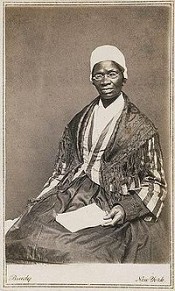Gilbert Olive

Sojourner Truth (1797 – November 26, 1883) was the self-given name, from 1843, of Isabella Baumfree, an African-American abolitionist and women's rights activist. Truth was born into slavery in Swartekill, New York. Her best-known speech, Ain't I a Woman?, was delivered in 1851 at the Ohio Women's Rights Convention in Akron, Ohio. She was one of thirteen children born to James and Elizabeth Baumfree, who were slaves of Colonel Hardenbergh. The Hardenbergh estate was in a hilly area called by the Dutch name Swartekill (just north of present-day Rifton), in the town of Esopus, New York, 95 miles north of New York City.[1] After the colonel's death, ownership of the family slaves passed to his son, Charles Hardenbergh. [2] After the death of Charles Hardenbergh in 1806, Truth, known as Belle, was sold at an auction. She was about 9 years old and was included with a flock of sheep for $100 to John Neely, near Kingston, New York. Until she was sold, Truth spoke only Dutch.[3] She suffered many hardships at the hands of Neely, whom she later described as cruel and harsh and who once beat her with a bundle of rods. Truth previously said Neely raped and beat her daily. Neely sold her in 1808, for $105, to Martinus Schryver of Port Ewen, a tavern keeper, who owned her for 18 months. Schryver sold her in 1810, for $175, to John Dumont of West Park, New York.[4] Although this fourth owner was kindly disposed toward her, his wife found numerous ways to harass Truth and make her life more difficult.[2] Around 1815, Truth met and fell in love with a slave named Robert from a neighboring farm. Robert's owner (Catlin) forbade the relationship; he did not want his slave to have children with a slave he did not own, because he would not own the children. Robert was savagely beaten and Truth never saw him again. Later, he died from the previous injuries.[5] In 1817, Truth was forced by Dumont to marry an older slave named Thomas. She had five children: Diana (1815), fathered by Robert; and Thomas who died shortly after birth, Peter (1821), Elizabeth (1825), and Sophia (ca. 1826), fathered by Thomas.[6] The state of New York began, in 1799, to legislate the abolition of slavery, although the process of emancipating New York slaves was not complete until July 4, 1827. Dumont had promised Truth freedom a year before the state emancipation, "if she would do well and be faithful." However, he changed his mind, claiming a hand injury had made her less productive. She was infuriated. She continued working until she felt she had done enough to satisfy her sense of obligation to him by spinning 100 pounds of wool. Late in 1826, Truth escaped to freedom with her infant daughter, Sophia. She had to leave her other children behind because they were not legally freed in the emancipation order until they had served as bound servants into their twenties.[3] She later said: She found her way to the home of Isaac and Maria Van Wagener, who took her and her baby in. Isaac offered to buy her services for the remainder of the year (until the state's emancipation took effect), which Dumont accepted for $20.[3] She lived there until the New York State Emancipation Act was approved a year later. Truth learned that her son Peter, then 5 years old, had been sold illegally by Dumont to an owner in Alabama. With the help of the Van Wageners, she took the issue to court and, after months of legal proceedings, got back her son, who had been abused by his new owner.[2] Truth became the first black woman to go to court against a white man and win the case. See also Mum Bett Truth had a life-changing religious experience during her stay with the Van Wageners, and became a devout Christian. In 1829 she moved with her son Peter to New York City, where she worked as a housekeeper for Elijah Pierson, a Christian Evangelist. In 1832, she met Robert Matthews, also known as Matthias Kingdom or Prophet Matthias, and went to work for him as a housekeeper.[2] In a bizarre twist of fate, Elijah Pierson died, and Robert Matthews and Truth were accused of stealing from and poisoning him. Both were acquitted and Robert Matthews moved west.[3] In 1839, Truth's son Peter took a job on a whaling ship called the Zone of Nantucket. From 1840 to 1841, she received three letters from him, though in his third letter he told her he had sent five. When the ship returned to port in 1842, Peter was not on board and Truth never heard from him again.[2] On June 1, 1843, Truth changed her name to Sojourner Truth and told her friends, "The Spirit calls me, and I must go." She became a Methodist, and left to make her way traveling and preaching about abolition. In 1844, she joined the Northampton Association of Education and Industry in Massachusetts. Founded by abolitionists, the organization supported women's rights and religious tolerance as well as pacifism. There were 210 members and they lived on 500 acres (2 km²), raising livestock, running a sawmill, a gristmill, and a silk factory. While there, Truth met William Lloyd Garrison, Frederick Douglass, and David Ruggles. In 1846, the group disbanded, unable to support itself.[3] In 1847, she went to work as a housekeeper for George Benson, the brother-in-law of William Lloyd Garrison. In 1849, she visited John Dumont before he moved west.[2] Truth started dictating her memoirs to her friend Olive Gilbert, and in 1850 William Lloyd Garrison privately published her book, The Narrative of Sojourner Truth: A Northern Slave.[3] That same year, she purchased a home in Northampton for $300, and spoke at the first National Women's Rights Convention in Worcester, Massachusetts. In 1851, Truth left Northampton to join George Thompson, an abolitionist and speaker. In May, she attended the Ohio Women's Rights Convention in Akron, Ohio where she delivered her famous speech later known as "Ain't I a Woman." The convention was organized by Hannah Tracy and Frances Dana Barker Gage, who both were present when Truth spoke. Different versions of Truth's words have been recorded, with the first one published a month later by Marius Robinson, a newspaper owner and editor who was in the audience. Robinson's recounting of the speech included no instance of the question "Ain't I a Woman?" Twelve years later in May 1863, Gage published another, very different, version. In it, Truth's speech pattern had characteristics of Southern slaves, and the speech included sentences and phrases that Robinson didn't report. Gage's version of the speech became the historic standard, and is known as "Ain't I a Woman?" because that question was repeated four times.[7] Truth's own speech pattern was not Southern in nature, as she was born and raised in New York, and spoke only Dutch until she was nine years old.[8] In contrast to Robinson's report, Gage's 1863 version included Truth saying her 13 children were sold away from her into slavery. Truth is widely believed to have had five children, with one sold away, and was never known to boast more children.[8] Gage's 1863 recollection of the convention conflicts with her own report directly after the convention: Gage wrote in 1851 that Akron in general and the press in particular were largely friendly to the woman's rights convention, but in 1863 she wrote that the convention leaders were fearful of the "mobbish" opponents.[8] Other eyewitness reports of Truth's speech told a calm story, one where all faces were "beaming with joyous gladness" at the session where Truth spoke; that not "one discordant note" interrupted the harmony of the proceedings.[8] In contemporary reports, Truth was warmly received by the convention-goers, the majority of whom were long-standing abolitionists, friendly to progressive ideas of race and civil rights.[8] In Gage's 1863 version, Truth was met with hisses, with voices calling to prevent her from speaking.[9] Over the next decade, Truth spoke before dozens, perhaps hundreds, of audiences. From 1851 to 1853, Truth worked with Marius Robinson, the editor of the Ohio Anti-Slavery Bugle, and traveled around that state speaking. In 1853, she spoke at a suffragist "mob convention" at the Broadway Tabernacle in New York City; that year she also met Harriet Beecher Stowe.[2] In 1856, she traveled to Battle Creek, Michigan, to speak to a group called the Friends of Human Progress. In 1858, someone interrupted a speech and accused her of being a man; Truth opened her blouse and revealed her breasts.[2][3] Truth sold her home in Northampton in 1857 and bought a house in Harmonia, Michigan, just west of Battle Creek.[3] According to the 1860 census, her household in Harmonia included her daughter, Elizabeth Banks (age 35), and her grandsons James Caldwell (misspelled as "Colvin"; age 16) and Sammy Banks (age 8).[2] During the Civil War, Truth helped recruit black troops for the Union Army. Her grandson, James Caldwell, enlisted in the 54th Massachusetts Regiment. In 1864, Truth was employed by the National Freedman's Relief Association in Washington, D.C., where she worked diligently to improve conditions for African-Americans. In October of that year, she met President Abraham Lincoln.[2] In 1865, while working at the Freedman's Hospital in Washington, Truth rode in the streetcars to help force their desegregation.[2] Truth is credited with writing a song, "The Valiant Soldiers", for the 1st Michigan Colored Regiment; it was said to be composed during the war and sung by her in Detroit and Washington, D.C. It is sung to the tune of "John Brown's Body" or "The Battle Hymn of the Republic". [10] Although Truth claimed to have written the words, it has been disputed (see Marching Song of the First Arkansas). In 1867, Truth moved from Harmonia to Battle Creek. In 1868, she traveled to western New York and visited with Amy Post, and continued traveling all over the East Coast. At a speaking engagement in Florence, Massachusetts, after she had just returned from a very tiring trip, when Truth was called upon to speak she stood up and said, In 1870, Truth tried to secure land grants from the federal government to former slaves, a project she pursued for seven years without success. While in Washington, D.C., she had a meeting with President Ulysses S. Grant in the White House. In 1872, she returned to Battle Creek and tried to vote in the presidential election, but was turned away at the polling place.
do you like this author?
What readers are saying
What do you think? Write your own comment on this book!
write a commentWhat readers are saying
What do you think? Write your own comment on this author!
write a commentBook list

narrative of sojourner truth a bondswoman of olden time
Series:
Unknown
Year:
Unknown
Raiting:
5/5
Show more
add to favoritesadd In favorites

narrative of sojourner truth a bonds woman of olden time emancipated by the ne
Series:
Unknown
Year:
Unknown
Raiting:
2.5/5
Show more
add to favoritesadd In favorites
Book list

narrative of sojourner truth a bondswoman of olden time
Series:
Unknown
Year:
Unknown
Raiting:
5/5
Show more
add to favoritesadd In favorites

narrative of sojourner truth a bonds woman of olden time emancipated by the ne
Series:
Unknown
Year:
Unknown
Raiting:
2.5/5
Show more
add to favoritesadd In favorites
What readers are saying
What do you think? Write your own comment on this author!
write a commentif you like Gilbert Olive try:
readers also enjoyed
What readers are saying
What do you think? Write your own comment on this author!
write a commentif you like Gilbert Olive try:
readers also enjoyed
Do you want to exchange books? It’s EASY!
Get registered and find other users who want to give their favourite books to good hands!

